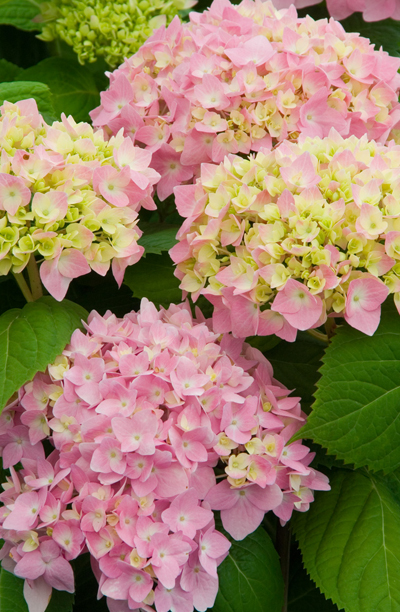Plant of the month - July - Hydrangea
Our plant of the month for July is the Hydrangea. The plant is enjoying a renaissance as this iconic bloom, so representative of the classic English garden. As last year proved, a cool wet summer really sees them thriving and producing glorious flowers over a long period, although they will happily perform in a sunny summer too.
Hydrangeas come in a range of shapes and sizes. 'Mop headed' varieties are probably the most recognisable with their 'mop' of florets clustered together in a range of lovely chalky shades. 'Lace-cap' varieties have fewer florets arranged around the perimeter of a boss of small flowers.
A new era has arrived for Hydrangeas, after 10 years of development in the USA, Endless Summer® is here. Unlike traditional mop-headed Hydrangeas, the Endless Summer range flowers on old and new wood, meaning beautiful blooms from June to October, regardless of late frosts or badly timed pruning. 'Endless Summer The Original' is available in pink and blue, 'The Bride' is a white form with a hint of blush pink.
Where can I plant Endless Summer?
Hydrangeas will thrive in a slightly shaded spot either planted in a border or large patio pot. They are also suited to seaside gardens.
Will they grow in any soil?
Yes, but a moist well-drained soil is best. If your soil is very dry apply a mulch in spring to help conserve moisture. The soil type will affect flower colour. A chalky soil turns a blue Hydrangea pink and an acid soil will make a pink Hydrangea blue. For an indication of your soil type, see what the predominant Hydrangea colour is in your neighbourhood.
How can I change the colour of my Hydrangeas?
It is possible to turn a pink Hydrangea blue by treating with a Hydrangea colourant, available from garden centres. Alternatively, grow in a large patio pot in ericaceous or lime-free compost and treat with colourant in the growing season.
How should I prune my Hydrangeas?
Pruning is simple and whatever happens you won't affect Endless Summer's ability to bloom. As a guide, leave the old flower heads in place through the winter. You can enjoy the winter silhouette of dried blooms dusted with snow and they also protect the new growth from early spring frost. As new shoots start to emerge in spring, cut back last year's flowering stems to a strong pair of buds.
Will I have blooms next year on pruned stems?
Yes, because of Endless Summer's ability to flower on old and new wood.
How should I dry the flowers for best effect?
The single most important thing about drying Hydrangeas is when you cut the bloom, fresh newly opened flowers seldom dry well. It is best to wait until the flowers begin to dry on their own. The petals will have faded a little and feel papery to the touch. Then the simplest method is to air dry them by stripping off the leaves and hanging them upside down in an airy place out of direct sunlight. Depending on air temperatures and humidity this can take several days to a couple of weeks.
How long have Hydrangeas been grown in the UK?
The original species macrophylla, which the Endless Summer range belongs to, is from Japan and was introduced into the UK by Ernest Wilson in 1917. 'Endless Summer The Original' was discovered by a nursery worker at Bailey Nurseries in Minnesota USA. Its big break came in 1998 when renowned horticulturist and Hydrangea expert, Dr Michael Dirr saw it in trials and was the first to recognise the plant's groundbreaking qualities, referring to the event as 'a horticultural miracle' in his book 'Hydrangeas for American Gardens'.





Comments
Post a Comment